The AMD Llano Notebook Review: Competing in the Mobile Market
by Jarred Walton & Anand Lal Shimpi on June 14, 2011 12:01 AM ESTFusion GPU Takes on Gaming
For our gaming tests, we’ll start with our Low and Medium detail gaming benchmarks. We’ll save Asymmetrical CrossFire and High detail gaming for the next page. Note that we run all of the Low and Medium tests using DX9/DX10 modes, even on games that support DX11. There reason is simple: in nearly every game with DX11 support, enabling it often proves too taxing for anything but the fastest discrete GPUs—or in other cases, the graphics quality difference is negligible (Civilization V, Metro 2033, and Total War: Shogun 2 fall into this category). When we refresh our list of games later this year, we might start testing DX11 more often, but for now we’ll stick with DX9/10 on mainstream laptop testing.
Low Detail Gaming
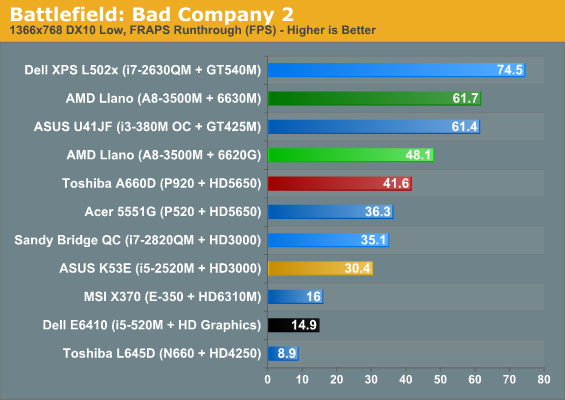
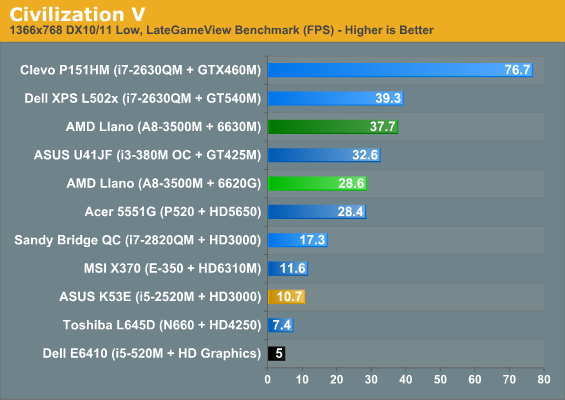

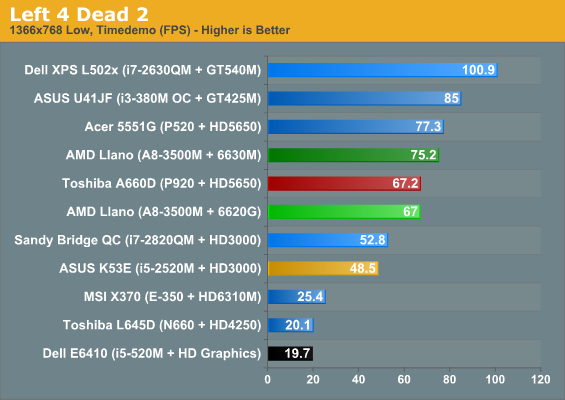
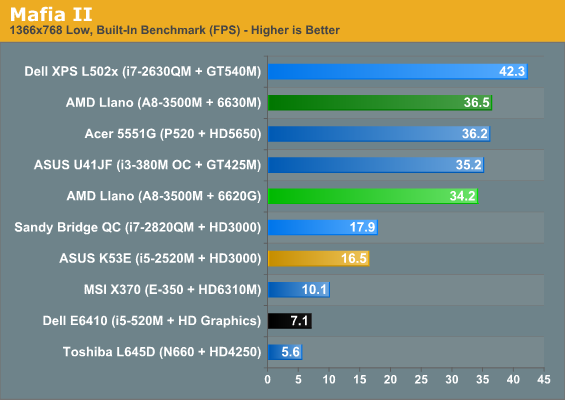

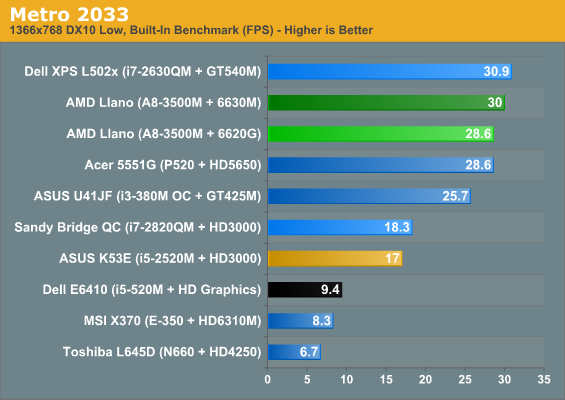
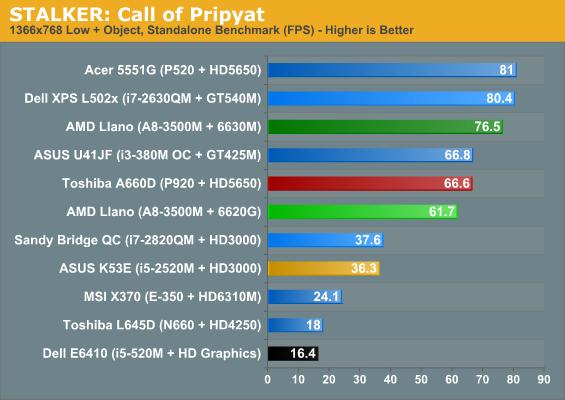
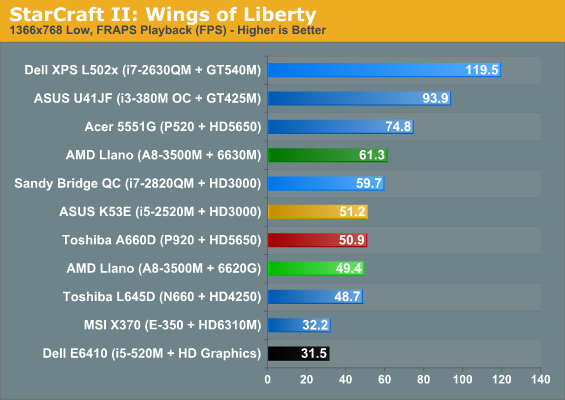
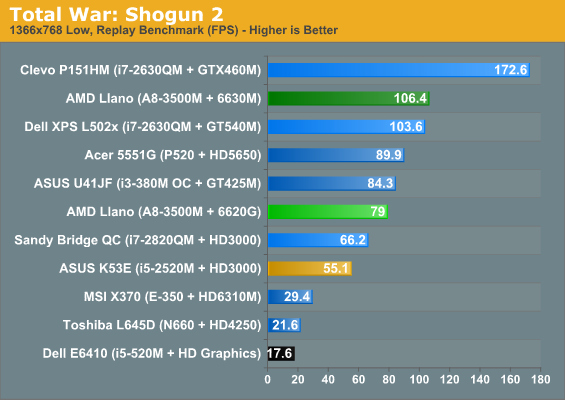
Medium Detail Gaming
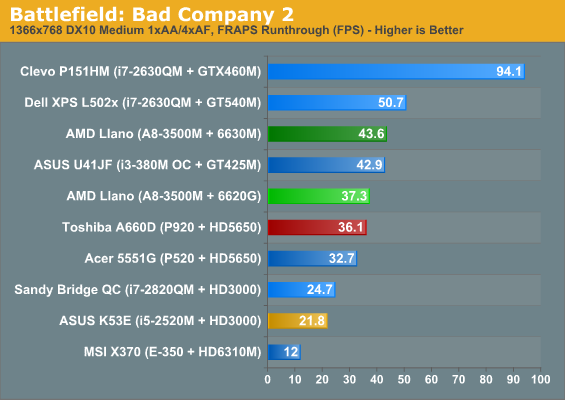
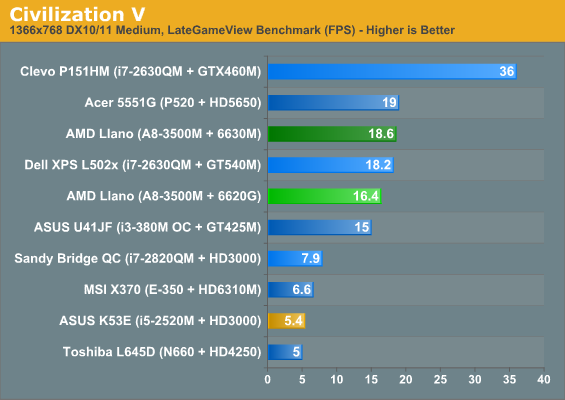
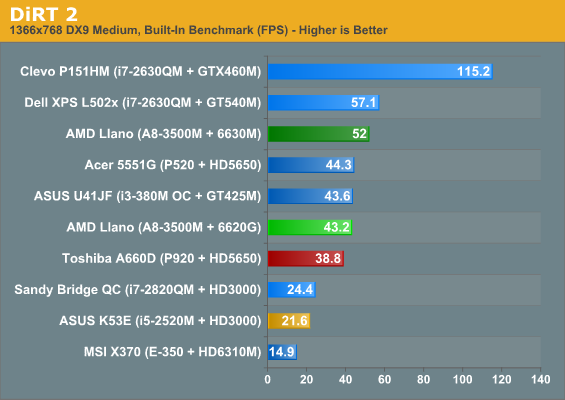
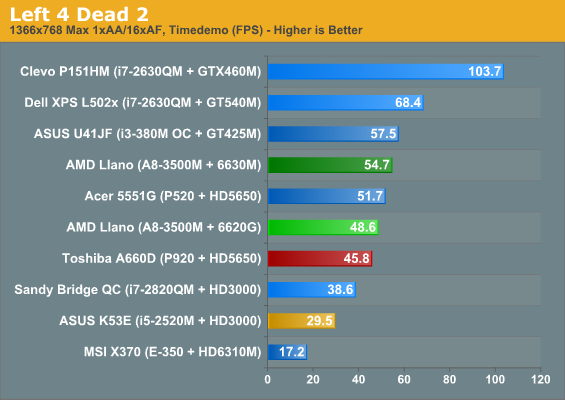

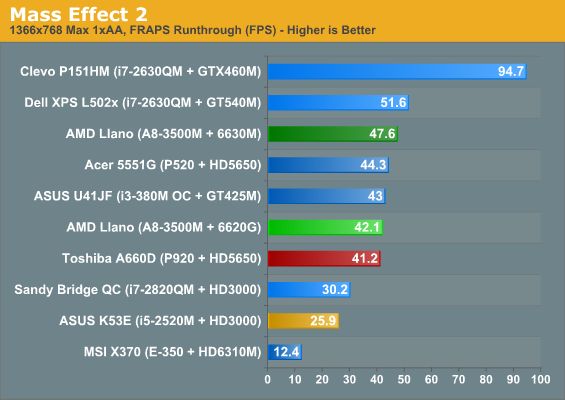
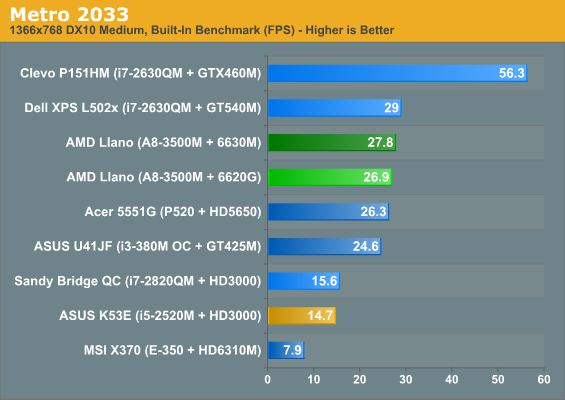
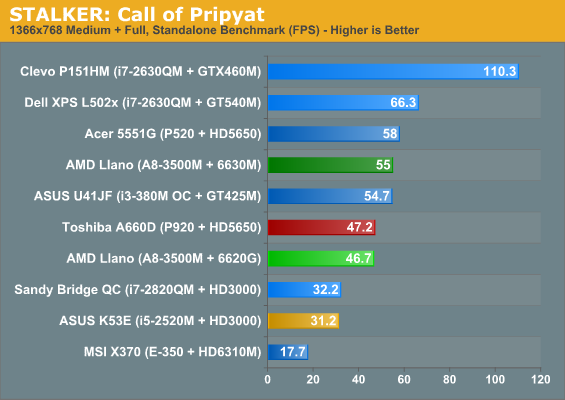
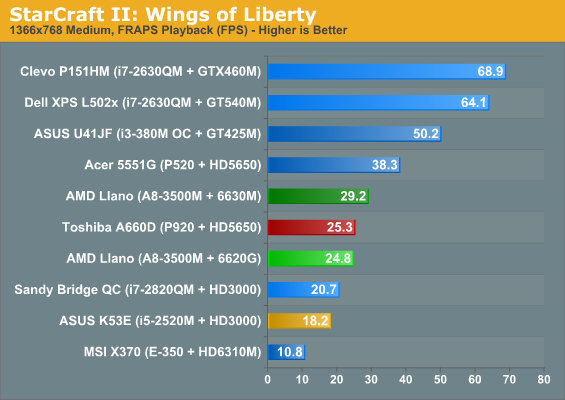
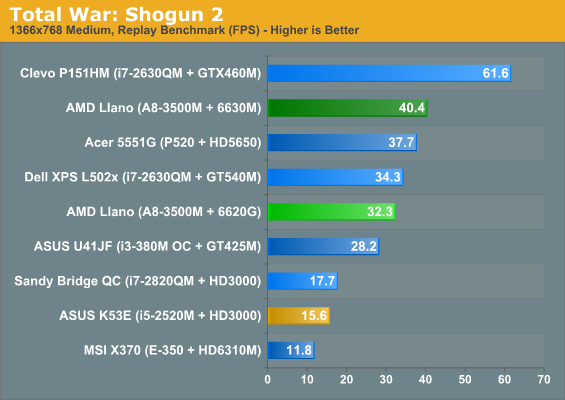
The age-old adage is that if you want a good gaming experience, you need to put more money into the graphics subsystem. With Llano, we need to modify that and add a corollary that you can trade a faster CPU for a better IGP/fGPU and end up with acceptable gaming performance. The 6620G is the first integrated GPU that can actually keep pace with the midrange discrete GPUs (at least on laptops—desktop GPUs are a different story). The Llano A8-3500M comes out ahead of AMD’s previous P920 + HD 5650 in many of the results, while A8-3500M + HD 6630M adds anywhere from 3-40% and averages 24% faster than the 6620G.
If we look at the competition, A8-3500M is anywhere from -3.5% to 167% faster than Intel’s HD 3000 with dual-core SNB, running everything at our Low presets. The sole victory for Intel comes in the lightly-threaded StarCraft II where Intel can really flex its Turbo Boost muscles. On the other end of the spectrum, HD 3000 turns in extremely poor results in Civilization V, Mafia II, and Metro 2033—games where Llano is at least playable. On average, the A8-3500M is 50% faster than HD 3000 at Low settings; move up to our Medium settings and Llano is 76% faster on average, with leads in every title ranging from 36% (StarCraft II is again the worst showing for AMD) to as much as 204% (Civilization V).
Bring the older Arrandale into the picture and things get even more lopsided. Never mind the fact that Arrandale’s HD Graphics are unable to break 30FPS in most of our test games at minimum detail (StarCraft II being the one exception); at our Low presets, A8-3500M puts Arrandale to shame, with performance anywhere from 57 to 472 percent faster and 223% faster on average. Obviously, you don’t want to try gaming on Arrandale’s IGP, which is where laptops like the ASUS U41JF come into play. You can pick up the U41JF for just over $800, but while the CPU is certainly faster, gaming performance with the GT 425M is only 15% faster than the stock A8-3500M on average, with Llano pulling wins in Civ5, Metro 2033, and TWS2 at Medium detail.
As a final note on gaming performance, while the A8-3500M isn’t clocked particularly high, there’s still more performance on tap in many games. Switching over to the 6630M dGPU improves performance by an average of 20% over the fGPU. A few titles only show an incremental performance increase (Metro 2033 and Mafia II); the biggest performance gains come in DiRT 2 and Total War: Shogun 2, with performance increases of 40%/35% respectively at low detail and 20%/25% at medium detail.
The target price of $700 for A8 laptops could make for a reasonably powerful and inexpensive gaming laptop, and if it’s like current AMD notebooks I suspect we’ll see A8 laptop prices dip into the low $600s. $800 for A8 Llano with the 6630M becomes a more difficult proposition, considering it would butt up squarely against laptops like the U41JF. Gaming performance would be similar, but the larger battery would give ASUS (and Intel) the lead in that area and gaming performance would be largely a wash. Depending on how much of a threat Intel deems Llano to be, we could see SNB laptops similar to the U41JF push pricing down, but for now Llano certainly fills a popular market niche.










177 Comments
View All Comments
phantom505 - Tuesday, June 14, 2011 - link
I went with a K325 in a Toshiba with a Radeon IGP. Nobody I have lent it out to has every complained about it being slow or incapable of doing what they wanted/needed to. I get about 5 hours of battery life consistently. I don't do too much that is CPU intensive but I hear people moan and groan about the E-350 and Atom both when they try to open 50MB+ ppt files. I have no such problems.I for one an quite happy to see that AMD is still leading this segment since most users will be quite happy with AMD. I'm finding it more and more that Intel may own the top end, but nobody I know cares in the slightest.
mino - Tuesday, June 14, 2011 - link
E-350 is generally faster than K325 + IGP. Then than that, I fully agree.ash9 - Tuesday, June 14, 2011 - link
In this price range, I think not, besides Open(X) applications will reveal the potential - its up to the application developers nowGaMEChld - Tuesday, June 14, 2011 - link
My netbook is a pain to use precisely because of its graphics. It cannot properly play youtube or movie files fluently. Aside from its multi-media problems, I don't try to do ridiculous things on a netbook, so the other components are not much of a factor for me. But if I can't even watch videos properly, then it's trash.Luckily, I got that netbook for free, so I'm not that sad about it. I'll probably sell it on eBay and get a Brazos netbook at some point.
hvakrg - Tuesday, June 14, 2011 - link
Yes, they're becoming primary machines, but what exactly do you need the CPU part for in a primary machine today? Let's face it most people use their computer to browse the web, listen to music and watch videos, all of which are either relying on the GPU today or is clearly moving in that direction.Intel will have an advantage in the hardcore CPU market probably forever due to them being years ahead of the competition in manufacturing processes, but what advantage does that give them when it comes to selling computers to the end user? Things like battery life and GPU performance is what will be weighted in the future.
Broheim - Wednesday, June 15, 2011 - link
personally I need it to compile thousands of lines of code sometimes several times a day, if I were to settle for a E-350 I'd die of old age long before I get my masters in computer science.... some of us actually gives our 2600k @ 4.5ghz a run for it's money.th G in GPU doesn't stand for General... the GPU can only do a few highly specialized tasks, it's never going to replace and will always rely on the CPU. Unless you're a gamer you benifit much more from a fast CPU than a fast GPU, and even as a gamer you still need a good CPU.
don't believe me? take a E-350 and do all the things you listed, then strap a HD6990 onto it and try and see if you can tell the difference...
trust me, you can't.
ET - Wednesday, June 15, 2011 - link
Compiling code is a minority application, although I did that at a pinch on a 1.2GHz Pentium M, so the E-350 would do as well. Certainly won't use it for my main development machine, I agree.Still, as hvakrg said, most users do web browsing, listen to music, watch video. The E-350 would work well enough for that.
sinigami - Wednesday, June 15, 2011 - link
>most users do web>browsing, listen to music,
>watch video. The E-350
>would work well enough
>for that.
The Atom also works well enough for that, for less money.
You might be pleasantly surprised to find that current Atom netbooks can play 720p MKVs. For netbook level video, that's "well enough".
As you said, for anything tougher than that, i wouldn't use it for my "main machine" either.
ionave - Thursday, June 16, 2011 - link
Why would you spend $2000 for an intel powered laptop when you can build a desktop to do computations for a quarter of the price at 20x the speed, and get a laptop for $400 to run code on the desktop remotely and use it for lighter tasks? I'm surprised that you are a masters student in computer science, because your lack of logic doesn't reflect it. Correct me if I'm wrong, but why would you compute on the go when you can let the code on a desktop or cluster while the laptop is safely powered down in your backpack?Also, I can run Super Mario Galaxy using dolphin (CPU intensive) emulator at full frame rate on my AMD Phenom II X2 BE, and the cores in the A8 are improved versions of Phenom II X4. You really need to get your facts straight, since the CPU is actually VERY good. Go look at the benchmarks and do your research
Broheim - Thursday, June 16, 2011 - link
he clearly said primary machine, so before you go around insulting me I'd suggest you learn how to read.the 2600K is a desktop CPU you douchebucket, I never said my main machine was a laptop, quite to the contrary.
what you can and can't do is of no interrest to me, but first off, I never mentioned the A8 I said E-350, again with the failure to read.
nevertheless...
K10 is not even a match for Nehalem, and so far behind Sandy bridge it's ridiculous.
I've seen the benchmarks, I've done my research and concluded that the A8 CPU is far from "VERY" good, have you done yours?